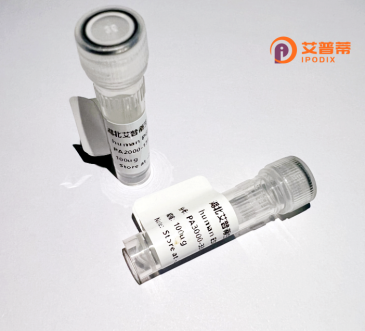
| 纯度 | >90%SDS-PAGE. |
| 种属 | Human |
| 靶点 | STK19 |
| Uniprot No | P49842 |
| 内毒素 | < 0.01EU/μg |
| 表达宿主 | E.coli |
| 表达区间 | 1-368 aa |
| 活性数据 | MQKWFSAFDD AIIQRQWRAN PSRGGGGVSF TKEVDTNVAT GAPPRRQRVP GRACPWREPI RGRRGARPGG GDAGGTPGET VRHCSAPEDP IFRFSSLHSY PFPGTIKSRD MSWKRHHLIP ETFGVKRRRK RGPVESDPLR GEPGSARAAV SELMQLFPRG LFEDALPPIV LRSQVYSLVP DRTVADRQLK ELQEQGEIRI VQLGFDLDAH GIIFTEDYRT RVCDCVLKAC DGRPYAGAVQ KFLASVLPAC GDLSFQQDQM TQTFGFRDSE ITHLVNAGVL TVRDAGSWWL AVPGAGRFIK YFVKGRQAVL SMVRKAKYRE LLLSELLGRR APVVVRLGLT YHVHDLIGAQ LVDCISTTSG TLLRLPET |
| 分子量 | 28.4 kDa |
| 蛋白标签 | His tag N-Terminus |
| 缓冲液 | PBS, pH7.4, containing 0.01% SKL, 1mM DTT, 5% Trehalose and Proclin300. |
| 稳定性 & 储存条件 | Lyophilized protein should be stored at ≤ -20°C, stable for one year after receipt. Reconstituted protein solution can be stored at 2-8°C for 2-7 days. Aliquots of reconstituted samples are stable at ≤ -20°C for 3 months. |
| 复溶 | Always centrifuge tubes before opening.Do not mix by vortex or pipetting. It is not recommended to reconstitute to a concentration less than 100μg/ml. Dissolve the lyophilized protein in distilled water. Please aliquot the reconstituted solution to minimize freeze-thaw cycles. |
以下是关于重组人STK19蛋白的参考文献摘要,涵盖功能研究、疾病机制和结构分析等方面:
---
1. **"Oncogenic mutations in STK19 drive NRAS-mediated melanomagenesis"**
*Ying et al. (2019), Nature Communications*
研究发现STK19通过磷酸化NRAS蛋白调控其活性,重组STK19蛋白体外实验证实其激酶活性对黑色素瘤细胞增殖的促进作用,揭示了STK19突变在致癌中的机制。
2. **"STK19 regulates DNA damage checkpoint signaling through phosphorylating BRCA1"**
*Huang et al. (2020), Cell Reports*
该文利用重组STK19蛋白证明其能与BRCA1相互作用,并在DNA损伤修复中通过磷酸化BRCA1调控细胞周期检查点,强调了其在基因组稳定性中的作用。
3. **"Structural insights into the autoinhibition and oncogenic activation of STK19 kinase"**
*Zhang et al. (2021), Journal of Biological Chemistry*
通过X射线晶体学和重组蛋白技术,解析了STK19的自抑制构象及致癌突变引起的结构变化,为靶向STK19的药物设计提供了结构基础。
4. **"STK19 deficiency suppresses hepatocellular carcinoma progression via ERK pathway inhibition"**
*Li et al. (2022), Cancer Science*
利用重组STK19蛋白验证其在肝癌细胞中通过ERK信号通路促进转移,敲低STK19可抑制肿瘤生长,提示其作为肝癌治疗潜在靶点。
---
这些研究综合展示了重组STK19蛋白在揭示其激酶功能、致癌机制及结构特性中的应用。如需全文建议通过PubMed或Sci-Hub获取。
The serine/threonine kinase 19 (STK19), also known as nuclear protein kinase 1 (NRK1), is an enzyme encoded by the STK19 gene in humans. It primarily localizes to the nucleus and plays roles in DNA damage response, transcriptional regulation, and cellular signaling pathways. Structurally, STK19 contains a conserved kinase domain that facilitates phosphorylation-dependent regulation of downstream targets. Early studies linked STK19 to melanomagenesis, as specific mutations in its coding region were identified in skin cancers. Subsequent research revealed broader implications, including its involvement in nucleotide excision repair (NER) by interacting with DNA damage sensors like UVSSA and regulating RNA polymerase II during transcription-coupled repair.
Recombinant human STK19 protein, generated via bacterial or mammalian expression systems, serves as a critical tool for in vitro studies. It enables biochemical characterization of kinase activity, substrate identification, and inhibitor screening. Dysregulation of STK19 has also been associated with autoimmune diseases, such as systemic lupus erythematosus (SLE), where autoantibodies targeting STK19 are detected. Recent findings suggest potential roles in chromatin remodeling and metabolic regulation, though mechanistic details remain under investigation. The protein’s dual functions in genome stability and immune responses highlight its therapeutic relevance, driving interest in developing modulators for cancer and autoimmune disorders.
×